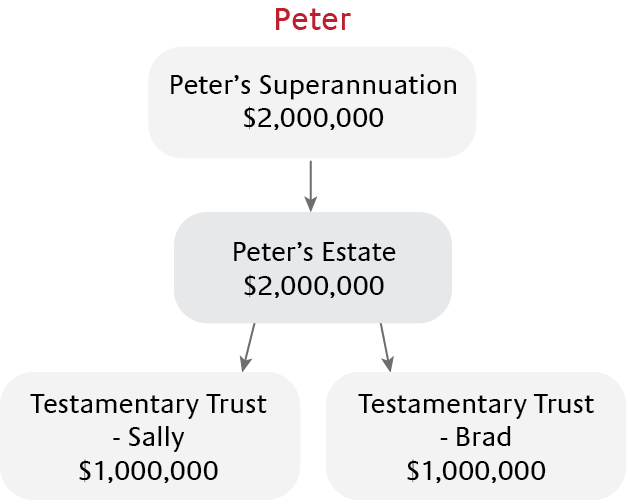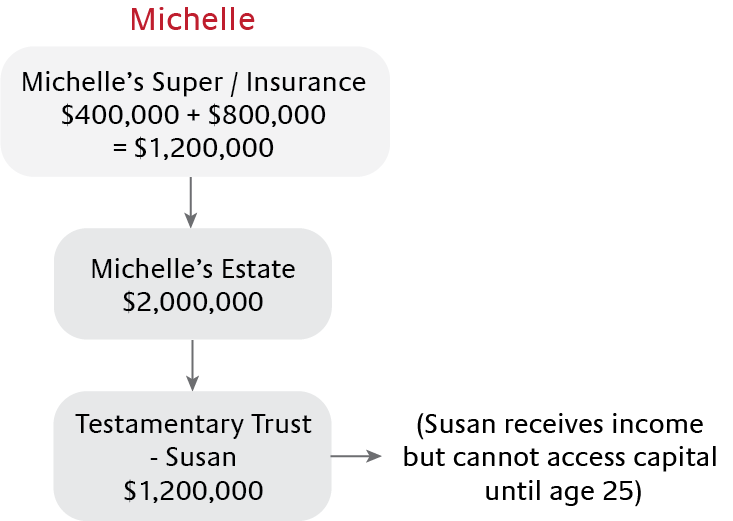Embarking on a new long-term relationship is an exciting time, especially for individuals who have come out of a relationship breakdown or endured the loss of a partner. Often in the process of organising their new life together, the new couple involved may lose track of the importance of preparing an estate plan to reflect their changed circumstances.
We have explored this in the following example where two families have come together later in life and need to organise their estate planning to reflect their wishes.
About the family
Peter and Michelle have been married for the past 5 years. Peter works as a medical practitioner, he is 60 years old and is looking forward to retiring shortly. Michelle works as a marketing consultant and is 54 years old. Michelle loves her work and intends to continue working for another 10 years.
Michelle has a daughter from a previous marriage, Susan who is 12 years of age. Susan lives with Michelle and Peter in the family home. Peter has two adult children from a previous marriage who both live independently. A daughter, Sally aged 32, who is a primary school teacher and has been married for one year with no children. And a son, Brad aged 29, who has been in a de-facto relationship for six months and runs his own landscaping business.
Peter currently has $2,000,000 in his superannuation fund and he plans to live off the earnings from this in his retirement years. Michelle is currently earning $120,000 per annum and has $400,000 in her superannuation fund, plus has life insurance cover of $800,000 which is owned through her superannuation fund. Peter and Michelle have not completed death benefit nomination forms for their respective superannuation funds.
Estate Planning strategy
Peter and Michelle decide to meet with a financial adviser to discuss their estate planning strategy.
At the meeting Peter mentions that his main goal is for his assets to pass through to his two children (Sally and Brad). Peter believes that in the event of his death, Michelle would be able to continue working and provide the necessary financial support for Susan. Peter also voices his concerns that his daughter’s marriage is on ‘shaky grounds’.
Michelle confirms that her main goal is for her assets to pass through to her daughter Susan. She is also concerned about who would look after Susan in the event of her death.
Apart from the family home the majority of Peter and Michelle’s wealth is held within the superannuation environment. The adviser explains that upon death, superannuation assets generally do not form part of an estate and they would need to specifically nominate where they would like their superannuation to be paid. The adviser highlights to Peter and Michelle that they have not made nominations on their superannuation funds and there is a risk that the trustee of the fund will determine who will receive their benefit, which may not be in accordance with their wishes.
The adviser recommends for both Peter and Michelle to implement binding death benefit nominations on their respective superannuation funds which will give them certainty that the trustee must pay the benefit to their nominated beneficiary.
As both Peter and Michelle would like to pass their estate through to their own surviving children, the financial adviser explains to them the option of nominating the estate to receive the superannuation death benefit. She also explains the potential benefits of incorporating a testamentary trust provision into their respective Wills.
The benefits of a testamentary trust for Peter and Michelle include:
- A reasonable degree of asset protection in the event of a marriage or de facto relationship breakdown in any of the family relationships, also in the event of bankruptcy. Peter can see the importance of asset protection given his concerns with his daughter’s marriage, and because his son runs his own business.
- The ability for the trustee to distribute income and capital from the trust in an optimal manner to manage overall tax and the ability to distribute income to children under the age of 18 at adult tax rates. Michelle’s daughter would be able to receive up to $21,884 per annum without paying any tax. Michelle understands that this will significantly benefit her daughter in the event of her death.
- The ability to specify an age at which Michelle’s daughter will be able to access capital from the testamentary trust.
The adviser then discusses with Michelle the importance of making a nomination in her Will for a legal guardian of Susan until she turns 18 years of age.
After the discussions with their adviser and solicitor Peter and Michelle decide to implement the following estate plan:
- Peter decides that he will make a binding superannuation death benefit nomination payable to his estate so that in the event of his death he has absolute certainty that the $2,000,000 held in his superannuation fund will pass to his estate. He also decides that he would like to set up separate testamentary trusts for Sally and Brad. Peter is comfortable that his assets will pass through to his children with a high degree of certainly, and also tax effectively via a testamentary trust.
- Michelle also decides to make a binding superannuation death benefit nomination to her estate so in the event of her death both her superannuation balance and life insurance cover totaling $1,200,000 will pass through her estate and to a testamentary trust for the benefit of her daughter, Susan. Michelle feels an element of comfort knowing that her daughter will not be able to withdraw capital from the trust until she reaches the age of 25. Michelle also decides to incorporate into her Will the nomination of her sister to be the legal guardian of Susan in the event of her death.


The example is illustrative only and is not an estimate of the investment returns you will receive or fees and costs you will incur. This example is based on the following assumptions:
(a) Michelle & Peter had paid off the family home so had no significant debt;
(b) The children receive no other taxable income
(c) Tax calculations are based on 2022/23 income tax rates.
If you have any questions regarding the above, contact Director and Financial Adviser, Gary Dean at gdean@prosperity.com.au. Alternatively you may contact your Principal Adviser on 1300 795 515 to discuss.
Disclaimer
This article contains information that is general in nature. It does not take into account the objectives, financial situation or needs of any particular person. You need to consider your financial situation and needs before making any decisions based on this information. You should not rely on the content of this article alone to make estate planning or financial planning decisions. Gary Dean is an authorised representative of Prosperity Wealth Advisory Services Pty Ltd (AFSL 533675).
